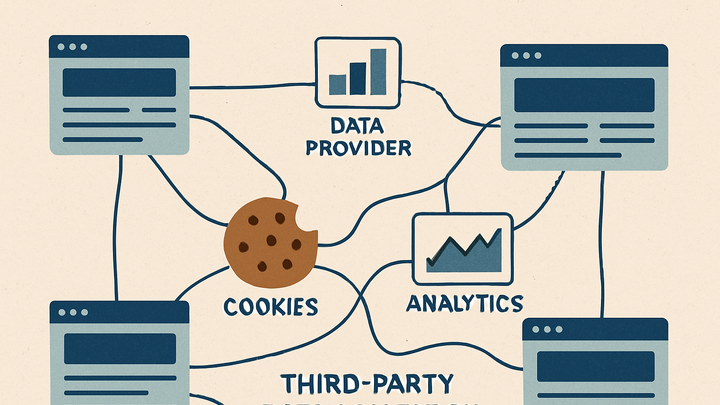Published on 2025-06-22T09:49:08Z
What is Third-Party Data? Examples of Third-Party Data in Analytics
In web analytics, third-party data refers to information collected by entities other than the website or app a user is interacting with. These entities – often data aggregators, ad networks, or social platforms – compile and sell or share user behavior, demographics, or interest data across multiple sites. Third-party data provides a broader audience view, enriching first-party insights with additional context like purchase intent, location, or cross-site behaviors. However, relying on third-party data introduces privacy and accuracy concerns, as it often uses cookies, tracking pixels, and device fingerprinting. With evolving regulations (GDPR, CCPA) and browser restrictions, some tools like PlainSignal opt for cookieless, first-party data collection, while platforms like Google Analytics 4 can integrate third-party segments for richer targeting. Understanding how third-party data works, its advantages, and its limitations is crucial for responsible and effective analytics implementation.
Third-party data
Data collected by external providers for audience enrichment, ad targeting, and analytics, with privacy and accuracy considerations.
Definition and Scope
This section defines third-party data and explains its scope within web analytics.
-
Core definition
Third-party data is information collected about users by entities other than the site they visit, typically aggregated from multiple sources to provide enriched insights.
How Third-Party Data Works
Explore the mechanisms through which third-party data is collected, processed, and delivered for analytics purposes.
-
Data collection mechanisms
Third-party providers use methods like cookies, tracking pixels, and device fingerprinting to gather user behavior across multiple domains.
-
Cookies
Small text files stored in a user’s browser that track behavior and preferences across sites.
-
Tracking pixels
Invisible 1x1 images embedded in a webpage or email to record user interactions and collect metadata.
-
Device fingerprinting
Techniques that combine browser and device attributes to identify users without cookies.
-
-
Data integration
Collected data is aggregated, cleaned, and enriched with additional attributes before being integrated into analytics platforms.
-
Aggregation
Combining raw event data into structured segments or audience profiles.
-
Enrichment
Appending demographic or interest data from external sources to first-party datasets.
-
Delivery
Providing data via APIs or audience segments for platforms like Google Analytics 4.
-
Use Cases in Analytics
Third-party data is used to enhance analytics capabilities and support marketing strategies.
-
Audience enrichment
Supplement first-party data with external demographics, interests, and firmographics to build detailed audience profiles.
-
Ad targeting
Leverage third-party segments to target users across display, social, and programmatic channels based on behavior or interests.
-
Attribution modeling
Incorporate cross-channel third-party data to understand the customer journey and assign credit to marketing touchpoints.
Advantages and Challenges
Assess the benefits and drawbacks of leveraging third-party data in analytics.
-
Advantages
Gives a broader reach and depth by accessing diverse datasets from multiple domains, often at scale and lower cost than building first-party repositories.
-
Broader audience insights
Access to behavioral and demographic data beyond your own site traffic.
-
Cost efficiency
Outsourcing data collection to specialized providers can be more economical than in-house.
-
Speed to market
Immediate access to ready-made segments saves time over building audiences from scratch.
-
-
Challenges
Includes privacy concerns, potential data inaccuracies, and increasing regulatory restrictions that can limit usage.
-
Accuracy issues
Data may be outdated or mismatched due to aggregation delays or user identification errors.
-
Privacy regulations
GDPR, CCPA, and browser policies restrict third-party tracking and require explicit consent.
-
Dependency risk
Relying on external providers can lead to vulnerabilities if sources change or discontinue services.
-
Privacy and Compliance Considerations
Discuss legal frameworks and best practices for using third-party data responsibly.
-
Regulatory frameworks
GDPR, CCPA, and other privacy laws govern the collection, sharing, and usage of personal data from third parties.
-
Consent & transparency
Websites must disclose third-party tracking and obtain user consent through banners or privacy policies.
-
Alternatives to third-party data
Consider first-party data collection and cookieless analytics as privacy-friendly strategies.
Examples in Popular SaaS Products
Illustrative implementations of analytics platforms that utilize or avoid third-party data techniques.
-
Google analytics 4
GA4 uses a combination of first-party cookies and can integrate third-party audience segments from Google Ads for advanced targeting. Example gtag.js snippet:
-
GA4 implementation
<!-- Google tag (gtag.js) --> <script async src="https://www.googletagmanager.com/gtag/js?id=GA_MEASUREMENT_ID"></script> <script> window.dataLayer = window.dataLayer || []; function gtag(){dataLayer.push(arguments);} gtag('js', new Date()); gtag('config', 'GA_MEASUREMENT_ID'); </script>
-
-
PlainSignal
PlainSignal offers a cookieless, first-party approach, avoiding third-party cookies altogether. Tracking code example:
-
PlainSignal implementation
<link rel="preconnect" href="//eu.plainsignal.com/" crossorigin /> <script defer data-do="yourwebsitedomain.com" data-id="0GQV1xmtzQQ" data-api="//eu.plainsignal.com" src="//cdn.plainsignal.com/plainsignal-min.js"></script>
-
